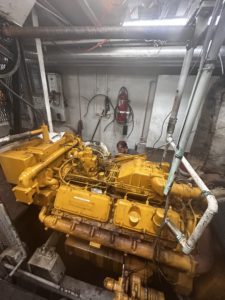February 4, 2025
Key Takeaways
1. The Hidden Costs of Machining
Key Hidden Costs of Machining:
Labor Costs
Additional Repairs
Downtime Costs
Multiple Shop Visits
Material Costs
Shipping and Handling
Precision Risks
Long-Term Uncertainty
2. Time Is Money: Minimizing Downtime
Key Factors Contributing to Downtime
Loss of Business Operations
Logistics and Shipping Delays
Risk of Incomplete Repairs
Increased Labor Costs for Idle Workers
Higher Rental Costs for Temporary Replacement Equipment
Customer Dissatisfaction Due to Service Delays
3. Reliability & Performance of a New Cylinder Head
Key Factors Affecting Reliability & Performance:
Structural Integrity
Improved Engineering
Factory-Tuned Components
Consistent Compression and Sealing
Reduced Risk of Overheating and Warping
Elimination of Past Wear and Fatigue
Long-Term Cost Savings and Durability
4. Warranty Protection and Long-Term Value
Key Benefits of a Warranty-Backed New Cylinder Head:
Manufacturer's Warranty
Better Resale Value
Lower Risk of Rework
Protection Against Defects and Failures
Increased Engine Reliability
Cost Savings on Future Repairs
5. Compatibility and Perfect Integration
Key Benefits of a New Cylinder Head for Integration
Matches OEM Specifications
Avoids Machining-Related Misalignment Issues
Reduces Installation Time and Complexity
6. Fuel Efficiency and Emissions Compliance
Key Issues Caused by a Worn-Out Cylinder Head:
Increased Fuel Consumption:
Higher Emissions
Loss of Power
Poor Air-Fuel Mixture Control
Overheating Risks
Inefficient Combustion Cycles
7. When a Machine Shop Is a Viable Option
Situations Where Re-Machining a Cylinder Head Makes Sense
Minimal Damage
Rare or Out-of-Production Parts
Budget Constraints
Limited Engine Use or Short-Term Application
Availability of High-Quality Machine Shop Services
Important Considerations When Choosing a Machine Shop
Final Thoughts: The Smarter Investment
Read More

December 31, 2024
Exhaust Valve and Injector Tube Guide For Detroit Diesel 53 Series Engines (3-53, 4-53, 6V53, 8V53)
Key Features of Exhaust Valves
Maintenance Guidelines
Valve Clearance Adjustment
Tools and Techniques for Valve Maintenance
Valve Spring Removal and Installation
Injector Tube Handling
Final Checks and Engine Operation
Sealing Techniques for the Cylinder Head – Detroit Diesel 53 Series (3-53, 4-53, 6V53, 8V53)
Key Sealing Components
Fuse Plugs for Overheating Protection
Proper Sealing Procedures
Preparation Before Installation
Gasket and Seal Installation
Installing the Cylinder Head
Cylinder Head Bolt Torqueing Sequence
Torque Specifications for Cylinder Head Bolts
Additional Considerations
Comprehensive Guide to Leak Testing for Detroit Diesel 53 Series Engines
Cooling System Pressure Test
Testing Procedure
If Leaks Are Detected
Fuel Leak Detection with Fluorescent Dye
Testing Procedure
Final Checks After Assembly
Compression Test
Coolant System Integrity Check
Inspection and Reconditioning Procedures
Steps for Cylinder Head Inspection and Reconditioning
Conclusion
Read More

December 18, 2024
1. Use Diesel Pro Power Premium Aftermarket Parts
2. Follow Torque Specifications
Regular Inspections of the Cylinder Head
Inspection Tools and Techniques
4. Keep Components Clean
5. Maintain Optimal Cooling System Performance
Why Cooling Matters:
6. Use Proper Lubrication
7. Record Maintenance Activities
Read More
December 18, 2024
Removing the Cylinder Head For Detroit Diesel V71 Engines
Preparation
Loosening Bolts
Lifting the Head
Inspection and Cleaning
Reassembly of the Cylinder Head
Installing New Valve Seat Inserts
Reinstalling Valves, Springs, and Rocker Arms
Install Valves
3. Install Valve Springs
Final Inspection
4. Torque Rocker Arms
Step-by-Step Procedure:
Replacing Injector Tubes
Reinstalling the Cylinder Head
Compression Gasket Installation
Tightening Sequence and Torque Specifications
Post-Installation Check
Read More
December 18, 2024
1. Replacing Valve Seat Inserts For Detroit Diesel 6V71, 8V71, 12V71, 16V71
Why It’s Necessary
Step-by-Step Process
2. Extract the Worn Inserts
3. Clean the Seat Bore
4. Install New Inserts
5. Lap the Valves (If Using Used Cylinder Head)
Final Steps
2. Replacing Fuel Injector Tubes For Detroit Diesel V71 Engines (6V71, 8V71, 12V71, 16V71)
Why It’s Necessary
Step-by-Step Process for Replacing Fuel Injector Tubes
Maintenance Tips for Fuel Injector Tubes
3. Checking and Maintaining Coolant Passages For Detroit Diesel V71 Engines (6V71, 8V71, 12V71, 16V71)
Why It’s Necessary
Step-by-Step Process for Checking and Maintaining Coolant Passages
Inspect for Damage
Maintenance Tips for Coolant Passages
4. Inspecting and Replacing Valve Components For Detroit Diesel V71 Engines (6V71, 8V71, 12V71, 16V71)
Why It’s Necessary
Step-by-Step Process for Inspecting and Replacing Valve Components
1. Remove the Valves
3. Replace Valve Seals
4. Reassemble Components
Maintenance Tips for Valve Components
5. Pressure Testing the Cylinder Head
6. Cleaning and Preparing the Cylinder Head
Additional Notes
Read More

December 18, 2024
Design Overview: Valve Layout, Injector Configuration, and Cooling System Integration
Cylinder Head Design For Detroit Diesel V71 Engines (6V71, 8V71, 12V71, 16V71):
Components of the Valve and Injector Operating Mechanism
3. Valve Bridges:
Cooling System Integration
Advanced Design Features
Maintenance and Serviceability
Common Maintenance and Repair Needs for the Detroit Diesel V71 Cylinder Head
Routine Cylinder Head Maintenance and Repairs
1. Replacing Valve Seat Inserts
2. Replacing Fuel Injector Tubes
3. Checking and Maintaining Coolant Passages
Step-by-Step Cylinder Head Removal, Inspection, Cleaning, and Reassembly
1. Removing the Cylinder Head
Cylinder Head Weights for Detroit Diesel V71 Engines
2. Inspection and Cleaning
3. Reassembly
Replace Injector Tubes:
Important Notes:
Reinstall the Cylinder Head On Detroit Diesel V71 Engines:
Important Notes:
Compression Gasket Installation
Tightening Sequence and Torque Specifications
1. Tightening Sequence
2. Torque Specifications
Tightening Procedure:
3. Final Checks
Best Practices for Cylinder Head Maintenance
Read More

Page 1 of 1012345...10...»Last »




 Free US Calls: 1-888-433-4735
Free US Calls: 1-888-433-4735 International: 305-545-5588
International: 305-545-5588



